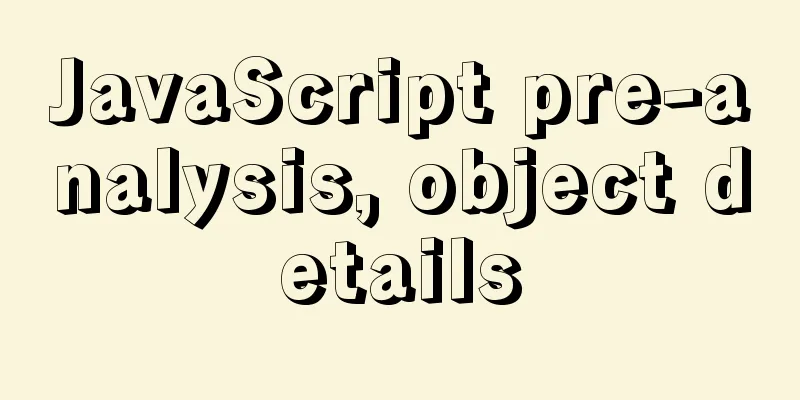JavaScript pre-analysis, object details

1. Pre-analysis1. Variable pre-parsing and function pre-parsingJavaScript code is executed by the JavaScript parser in the browser. The JavaScript parser runs JavaScript code in two steps: pre-parsing and code execution.
Preparing only happens for variables and functions defined with var. Learning pre-analysis can help us understand why the value of a variable is undefined when accessed before it is declared, and why a function can be called before it is declared. Preparing is also called variable and function promotion. 1. Variable pre-parsing Variable pre-parsing: Variable declarations will be promoted to the top of the current scope, and variable assignments will not be promoted. For example: /* Parse the var variable num first Then execute the console output and finally assign 10 to num*/ console.log(num); // What is the result? var num = 10; // ? 2. Function pre-analysisFunction pre-analysis : The function declaration will be promoted to the top of the current scope, but the function will not be called.
/*First parse the definition of the fn function and then execute the console statement*/
console.log("1+2+3+...+100=",fn());
function fn(){
var s = 0;
for(var i=1;i<=100;i++){
s += i;
}
return s;
}
2. Pre-analysis caseLet's do a little exercise and see what the output is.
console.log((a));
var a = 1;
console.log((a));
function a(){
return a;
}
The result is:
2. Target In JavaScript, an object is an unordered collection of related properties and methods. Everything is an object, such as strings, numbers, arrays, functions, and so on.
1. Three ways to create objects1. Create objects using literalsObject literal: The curly braces { } contain the properties and methods that express this specific thing (object). { } is expressed in the form of key-value pairs.
var star = {
name : 'xl',
age: 18,
sex : 'female',
sayStudy : function(){
console.log('Study hard');
}
};
The property call in the object is: object.property name, the dot . is understood as "of". For example: Another way to call the attributes in an object: object['attribute name'], note that the attributes in the square brackets must be quoted. For example: 2. Create an object using new ObjectThis is the same as the principle of creating an array using new Array() that we learned earlier.
var andy = new Object();
andy.name = 'xl';
andy.age = 18;
andy.sex = 'female';
andy.sayStudy = function(){
console.log('Study hard');
}
3. Create objects using constructors Constructor: A special function that is mainly used to initialize objects, that is, to assign initial values to object member variables. It is always used with the new operator. We can extract some common properties and methods from the object and encapsulate them into this function. In js, when using the constructor, pay attention to the following two points:
For example:
function MyName(name,age,sex){
this.name = name;
this.age = age;
this.sex = sex;
}
var xl = new MyName('熊柳','18','女');
var huan = new MyName('王欢','16','女');
console.log('xl.name='+xl.name);
console.log('huan:');
console.log(huan);
The print result is:
Notice
4. Constructors and objects
2. New Keywordnew does four things when executed: 1. Create a new empty object in memory. 2. Let this point to the new object. 3. Execute the code in the constructor to add properties and methods to the new object. 4. Return this new object (so no return is needed in the constructor). 3. Traversing object properties The for...in statement is used to loop over the properties of an array or object. Its syntax is as follows:
for (variable in object name) {
// Execute code here }
The variables in the syntax are custom and need to comply with naming conventions. Usually we write this variable as k or key.
for (var k in obj) {
console.log(k); // here k is the property name console.log(obj[k]); // here obj[k] is the property value}
For example, the following object is constructed
function Hero(name,type,blood,attack){
this.name = name;
this.type = type;
this.blood = blood;
this.attack = attack;
}
var lianpo = new Hero('Lian Po', 'Power', '500 HP', 'Melee');
var houyi = new Hero('Houyi','shooter type','100 health','long range');
When executing the for..in statement, printing k and obj[k] will produce the following results respectively:
function Hero(name,type,blood,attack){
this.name = name;
this.type = type;
this.blood = blood;
this.attack = attack;
}
var lianpo = new Hero('Lian Po', 'Power', '500 HP', 'Melee');
var houyi = new Hero('Houyi','shooter type','100 health','long range');
for(k in lianpo){
console.log(lianpo[k]);
}
SummarizeThis article ends here. I hope it can be helpful to you. I also hope that you can pay more attention to more content on 123WORDPRESS.COM! You may also be interested in:
|
<<: Web Design Tutorial (6): Keep your passion for design
>>: The image element img has extra blank space in IE6
Recommend
Detailed explanation of mysql trigger example
Table of contents What is a trigger Create a trig...
Rules for using mysql joint indexes
A joint index is also called a composite index. F...
Solution to 1449 and 1045 exceptions when connecting to MySQL
Solution to 1449 and 1045 exceptions when connect...
HTML code to add quantity badge to message button
HTML code: <a onclick="goMessage();"...
Tutorial on installing MySQL 8.0.11 using RPM on Linux (CentOS7)
Table of contents 1. Installation preparation 1. ...
Introduction to Semantic HTML Tags
In the past few years, DIV+CSS was very popular in...
Pure CSS to achieve cloudy weather icon effect
Effect The effect is as follows Implementation ...
Detailed steps for embedding Baidu Maps in web pages and using Baidu Maps API to customize maps
Insert Baidu Map into the web page If you want to...
Guide to using env in vue cli
Table of contents Preface Introduction-Official E...
Solution to the conflict between nginx and backend port
question: When developing the Alice management sy...
Sharing of SQL optimization experience when offset is too large during MySQL paging
Find the problem When we display the contents in ...
Graphic tutorial for installing MySQL 5.6.35 on Windows 10 64-bit
1. Download MySQL Community Server 5.6.35 Downloa...
How to modify the forgotten password when installing MySQL on Mac
1. Install MySQL database on mac 1. Download MySQ...
Example of assigning values to ActiveX control properties by param name in a web page
Copy code The code is as follows: <HTML> &l...
vue-router history mode server-side configuration process record
history route History mode refers to the mode of ...













